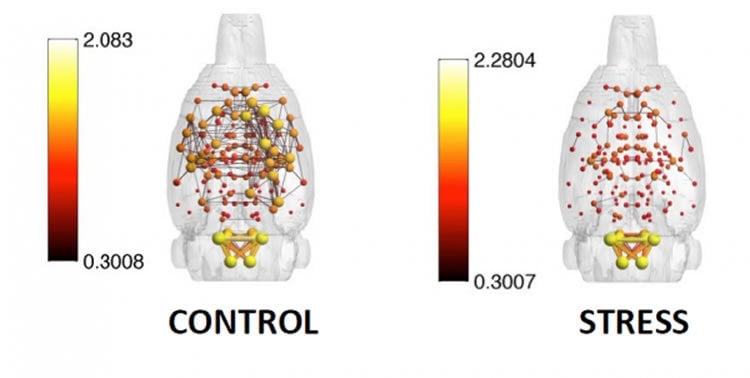Summary: Findings about how early life social stress affect brain connections in mice may have implications for treating human psychiatric illnesses.
Source: Tufts University.
Changes in connectivity in regions of the brain tied to social behavior, stress and depression can inform research on related psychiatric disorders in humans.
Investigators in veterinary and human medicine have uncovered long-term changes in the brains of adult female rats exposed to social stresses early in life, with the biggest impact on regions of the brain that are linked to social behavior, stress, emotion and depression. The findings, which appear online in advance of the January 2017 print edition of Behavioural Brain Research, establish a neural foundation for related imaging work in humans and animals and will enable researchers to begin testing preventative measures and treatments for depression and anxiety.
A team led by Benjamin Nephew, assistant professor at Cummings School of Veterinary Medicine at Tufts University, studied adult female rats exposed to early life chronic social stress (ECSS). Using an ECSS model that was established in Nephew’s previous research on postpartum depression and anxiety, the female rats in the test group were exposed to social stress in their first two weeks of life as pups, while the control group was not exposed to social stress. Previous studies looking at animal models of depression and anxiety have focused primarily on males. The current research can provide important insight into the development of these psychiatric disorders in females.
When the rats reached adulthood (65-90 days old), functional magnetic resonance imaging (fMRI) was administered to measure resting state functional connectivity—the fluctuation in activity in different regions of the brain.
Analysis of the imaging from the ECSS group showed broad changes in activity in areas of the brain that control, among other things, rewards, social behavior, stress and depression. This study was the first to measure resting state functional connectivity in conscious rats in a model of depression. Using fMRI enabled researchers to identify changes in multiple neural circuits simultaneously.
“Conscious rodent imaging allows us to make significant comparisons with human work, as well as integrate past rodent work that focused on individual nuclei to make conclusions about neural networks that control behavior,” said Nephew, the paper’s corresponding author.

“Comparing the data from the imaging with clinical models can enhance understanding of susceptibility, resilience, pathological origin and treatment response,” added Dr. Jean King, an author on the study and director of the Center for Comparative NeuroImaging at University of Massachusetts Medical School.
“We can now begin to test preventative measures and treatments for depression and anxiety—some of which may be unique to females—and assess how they affect both behavior and neural activity in several of the networks that were most affected by social stress in this study,” Nephew concluded.
Additional study authors are Wei Huang (currently at Massachusetts Institute of Technology), and Guillaume L. Poirier and Laurellee Payne, University of Massachusetts Medical School.
Funding: This work was supported by an award from the National Institute of Child Health and Human Development of the National Institutes of Health (HD059943) and a Brain and Behavior Research Foundation NARSAD Young Investigator Award to Nephew, as well as an award from the Office of the Director of the National Institutes of Health (OD018132-01) to the Center for Comparative NeuroImaging at University of Massachusetts Medical School.
Source: Tara Pettinato – Tufts University
Image Source: NeuroscienceNews.com image is credited to Marcelo Febo/University of Florida.
Original Research: Abstract for “A balance between elongation and trimming regulates telomere stability in stem cells” by Benjamin C. Nephew, Wei Huang, Guillaume L. Poirier, Laurellee Payne, and Jean A. King in Behavioural Brain Research. Published online December 2016 doi:10.1016/j.bbr.2016.08.051
[cbtabs][cbtab title=”MLA”]Tufts University “Early Life Social Stress Has Long Term Impact on Brain Networks: Rat Study.” NeuroscienceNews. NeuroscienceNews, 19 December 2016.
<https://neurosciencenews.com/social-stress-brain-network-5773/>.[/cbtab][cbtab title=”APA”]Tufts University (2016, December 19). Early Life Social Stress Has Long Term Impact on Brain Networks: Rat Study. NeuroscienceNew. Retrieved December 19, 2016 from https://neurosciencenews.com/social-stress-brain-network-5773/[/cbtab][cbtab title=”Chicago”]Tufts University “Early Life Social Stress Has Long Term Impact on Brain Networks: Rat Study.” https://neurosciencenews.com/social-stress-brain-network-5773/ (accessed December 19, 2016).[/cbtab][/cbtabs]
Abstract
A balance between elongation and trimming regulates telomere stability in stem cells
The use of a variety of neuroanatomical techniques has led to a greater understanding of the adverse effects of stress on psychiatric health. One recent advance that has been particularly valuable is the development of resting state functional connectivity (RSFC) in clinical studies. The current study investigates changes in RSFC in F1 adult female rats exposed to the early life chronic social stress (ECSS) of the daily introduction of a novel male intruder to the cage of their F0 mothers while the F1 pups are in the cage. This ECSS for the F1 animals consists of depressed maternal care from their F0 mothers and exposure to conflict between their F0 mothers and intruder males. Analyses of the functional connectivity data in ECSS exposed adult females versus control females reveal broad changes in the limbic and reward systems, the salience and introspective socioaffective networks, and several additional stress and social behavior associated nuclei. Substantial changes in connectivity were found in the prefrontal cortex, nucleus accumbens, hippocampus, and somatosensory cortex. The current rodent RSFC data support the hypothesis that the exposure to early life social stress has long term effects on neural connectivity in numerous social behavior, stress, and depression relevant brain nuclei. Future conscious rodent RSFC studies can build on the wealth of data generated from previous neuroanatomical studies of early life stress and enhance translational connectivity between animal and human fMRI studies in the development of novel preventative measures and treatments.
“A balance between elongation and trimming regulates telomere stability in stem cells” by Benjamin C. Nephew, Wei Huang, Guillaume L. Poirier, Laurellee Payne, and Jean A. King in Behavioural Brain Research. Published online December 2016 doi:10.1016/j.bbr.2016.08.051






